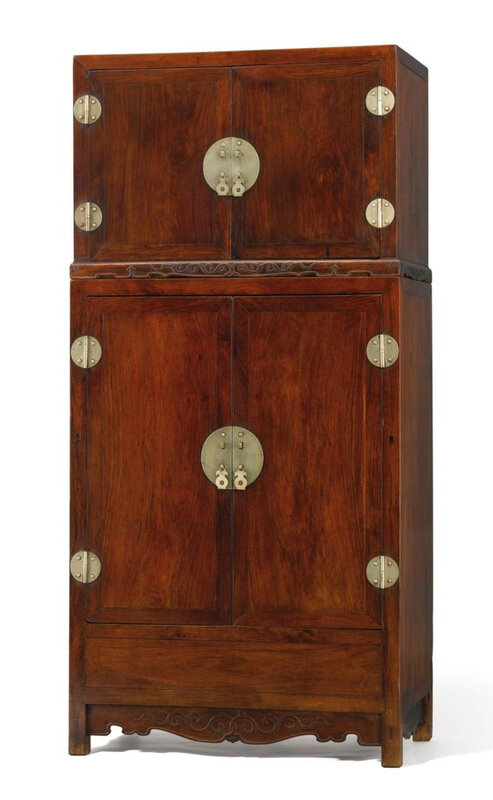A huanghuali compound cabinet with stand, sijiangui, Late Ming dynasty



Lot 122. A huanghuali compound cabinet with stand, sijiangui, Late Ming dynasty; 174.7 by 83.5 by 48.5 cm., 68 5/8 by 32 7/8 by 19 1/8 in. Estimate 3,000,000 — 5,000,000 HKD. Lot Sold 7,520,000 HKD (864,469 EUR). Courtesy Sotheby's.
comprising a small top cabinet on a stand resting on a larger bottom one, the top cabinet of mitre, mortise, tenon, tongue-and-grooved flush floating-panel construction with four square uprights, pyramid-joined to the top with one tenon exposed, mortise-and-tennoned to a stand of mitre, mortise and tenon frame construction with exposed tenons on the short sides, carved on the front and the sides with a beaded-edged curvilinear shape and decorated with stylised scrolling tendrils, the top cabinet set recessed from the stand, the stand supported on the top of the bottom cabinet of a corresponding size, the top of the bottom cabinet of standard, mitre, mortise, tenon, tongue-and-grooved, flush, floating panel construction with exposed tenons on the short sides, the four uprights pyramid-joined to the top with exposed tenons, the side panels and the removable doors on both the top and bottom cabinets of the same mitre, mortise, tenon, tongue-and-grooved, flush, floating-panel construction, two mitred stretchers with a tongue-and-grooved panel in between, below the doors of the main cabinet, above a beaded-edged, curvilinear apron carved with stylised scrolling tendrils, the side aprons similarly decorated, the interior of the top cabinet with one removable shelf, the bottom with one permanent central section with two drawers, the baitong circular hinges surface-mounted by four round headed pins, the similarly surface-mounted central circular plates with two openings for the lock receptacles and shaped door pulls with huangtong openwork inlay.
Exhibited: The Chinese Collections, Asian Civilisations Museum, Singapore, 1997-99.
Grace Wu Bruce, Chan Chair and Qin Bench: The Dr. S. Y. Yip Collection of Classic Chinese Furniture II, Art Museum, Chinese University of Hong Kong, Hong Kong, 1998, cat. no. 24, pp. 106-107.
Freer Gallery of Art and Arthur M. Sackler Gallery, Smithsonian Institution, Washington D.C., 2000-02.
Grace Wu Bruce, Grace Wu Bruce presents a choice selection of Ming Furniture from the Dr. S. Y. Yip collections, Hong Kong Convention and Exhibition Centre, Hong Kong, 2012, pp. 44-45.
Literature: Wang Shixiang, 'Additional Example of Classical Chinese Furniture', Orientations, January 1992, p. 47.
Wang Shixiang, 'Mingshi jiaju shili zengbu [Additional Example of Classical Chinese Furniture]', Mingshi jiaju yanjiu [Study of Ming-style Furniture], Beijing, 2008, p. 402.
Grace Wu Bruce, Two Decades of Ming Furniture, Beijing, 2010, p. 210.
Grace Wu Bruce, Ming Furniture Through My Eyes, Beijing, 2015, p. 214.
Note: "My favourite – the only other piece extant is at the Guimet Museum in Paris."
This compound cabinet differs from the classic type in which the top piece is finished with a base stand of a corresponding size with the bottom cabinet. This feature results in the top cabinet body being slightly smaller than the base cabinet.
The development of this design from the classic compound cabinet was probably to facilitate a dual usage allowing the top piece to be placed on floor level when required. This would explain why there are so few surviving examples as separate placements meant they were easily dislocated.
See Gustav Ecke, Chinese Domestic Furniture, Beijing, 1944, reprinted by Charles E. Tuttle, Rutland, Vermont and Tokyo, 1962, pl. 134, no. 106 for an example of a compound cabinet with stand, but of different proportion to the present piece, now in the Musee Guimet, Paris.
Sotheby's. Ming Furniture – The Dr S Y Yip Collection, Hong Kong, 07 October 2015

/https%3A%2F%2Fprofilepics.canalblog.com%2Fprofilepics%2F1%2F0%2F100183.jpg)
/https%3A%2F%2Fstorage.canalblog.com%2F03%2F02%2F119589%2F96711876_o.jpg)
/https%3A%2F%2Fstorage.canalblog.com%2F11%2F31%2F119589%2F94773502_o.jpg)
/https%3A%2F%2Fstorage.canalblog.com%2F20%2F83%2F119589%2F94772815_o.jpg)
/https%3A%2F%2Fstorage.canalblog.com%2F26%2F72%2F119589%2F75604929_o.jpg)
/https%3A%2F%2Fstorage.canalblog.com%2F59%2F60%2F119589%2F26458628_o.jpg)



/image%2F1371349%2F20240409%2Fob_fc01a6_2024-nyr-22642-0899-000-a-rare-small-h.jpg)
/image%2F1371349%2F20240409%2Fob_1299ed_2024-nyr-22642-0898-000-a-rare-huanghu.jpg)
/image%2F1371349%2F20240403%2Fob_b08891_telechargement-4.jpg)
/image%2F1371349%2F20240403%2Fob_b24488_telechargement.jpg)